It’s no question that wedding photography is demanding — and taking it up a notch to wedding film photography increases that pressure tenfold. When it comes to capturing weddings on film, you want to select the right film stock that is able to accommodate the agile and demanding nature of wedding days. Proper exposing and portrait capture are crucial when selecting your film stocks — and elements such as film speed, skin tone capture, exposure latitude, and more play into how you photograph a wedding.
It can be overwhelming to pick the right film stock for such a big day, but you’ve come to the right place! We’ve gathered some of the best film for wedding photography for you to get started.
Want more film photography tips? Join our mailing list, and check out our several other film photography guides.
Wedding Film Photography Criteria & Basics
A common theme across wedding photography film picks will be versatility. This versatility comes in the form of mid to high speed (aka high ISO) film stocks, which are adaptable to the changing conditions within a wedding day.
Another versatility feature is the film’s ability to be either over or under exposed, and still result in viable images with minimal grain or faded appearance. In other words, the film’s exposure latitude and ability to produce a proper image between differently environments.
Lastly, it’s important to consider how a given film stock captures portraits – because that’s ultimately what wedding photos are: a collection of constantly changing, constantly moving portraits captured throughout the day! You want to pay attention to a film stock’s ability to capture and reproduce skin tones to your liking, while also balancing out those skin tones with the tones of the portrait’s surroundings.
Best Film for Wedding Photography
Now that you know what to keep an eye out for with wedding film stocks – here are some of our picks to get started with shooting a wedding on film!
Kodak Portra 800
Kodak’s Portra line is loved for its warm tones, soft contrast, and incredible exposure latitude. If you plan to add Portra to the mix of your wedding film photography stack, most photographers opt for its highest speed option: Kodak Portra 800. Portra 800’s higher light sensitivity ultimately means more versatility to shoot at a higher shutter speed, and shoot in environments where light is less abundant. This is perfect for changing conditions on a wedding day, such as going between indoors and outdoors at a venue.
A caveat of higher ISO is more noticeable grain – but if exposed properly, grain is minimized. Wedding photographers often choose to overexpose Portra 800 by shooting it 1 to 2 stops below its box speed. As much as we love Portra and its warmer reproduction of skin tones, one thing to watch out for is shooting in warmer lighting, as this can cause those skin tones to look exaggerated. All in all, Portra 800 is a great film stock that a good majority of wedding film photographers like to carry with them.
Check out Kodak Portra 800:
- Portra 800 35mm Film: Get it on Amazon | Get it on Moment
- Portra 800 Medium Format (120) Film: Get it on Amazon | Get it on Moment
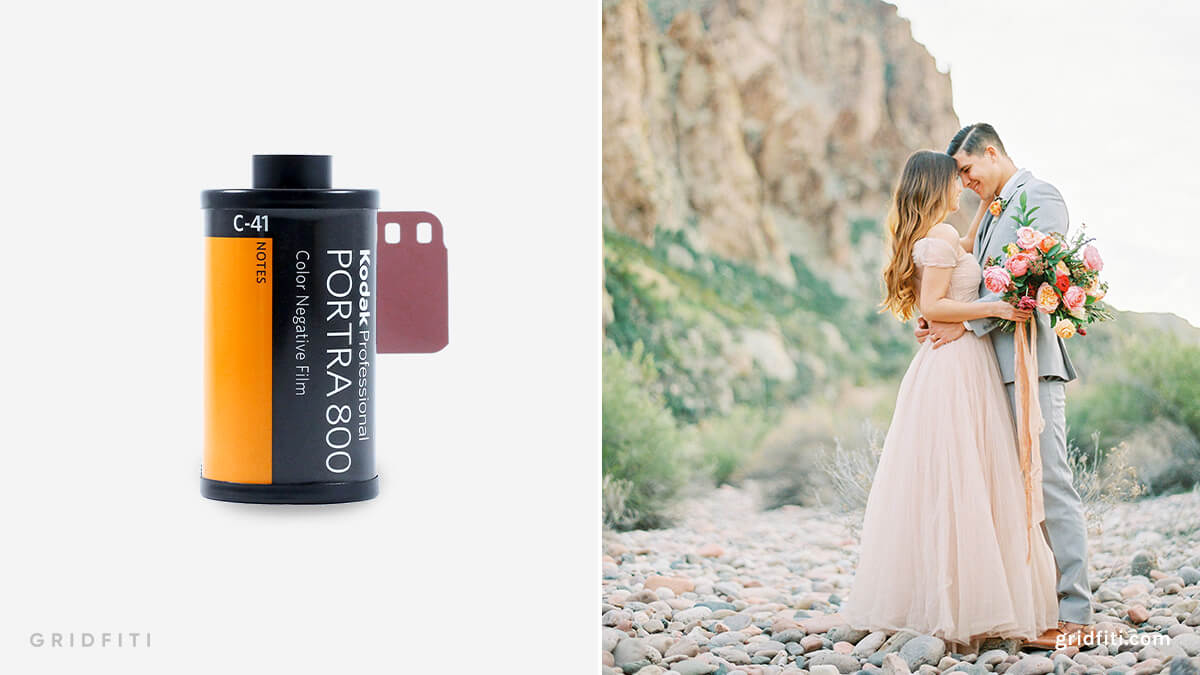 Photo by Carmencita Film Lab on Pinterest
Photo by Carmencita Film Lab on Pinterest
Kodak Portra 400
Kodak Portra 400, on the other hand, is a great lower speed counterpart to Portra 800. Why choose a lower speed, you ask? This film stock provides you with finer grain, and a little bit more control with underexposing to get you sharper contrast. Its grain is definitely finer than Portra 800, but the lower speed allows you to shoot 1 to 2 stops above box speed, getting you starker contrast in your shots if you’re looking to create some dramatic and darker looks.
Portra 400 still comes with that great Portra exposure latitude, but it does get limiting in lower light and indoor shooting. The compromise? Wedding photographers sometimes carry two separate film cameras with Portra 400 and 800 to adapt and choose based on any changing light throughout the day!
Check out Kodak Portra 400:
- Portra 400 35mm Film: Get it on Amazon | Get it on Moment
- Portra 400 Medium Format (120) Film: Get it on Amazon | Get it on Moment
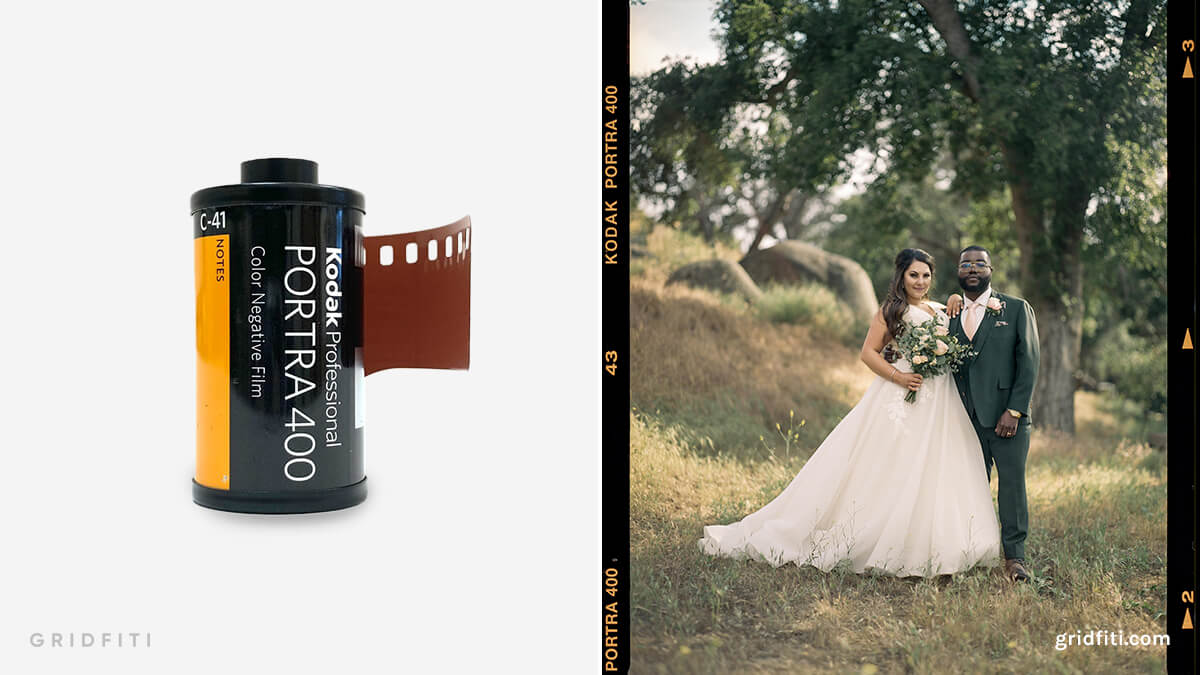 Photo by u/roycastro94 on Reddit
Photo by u/roycastro94 on Reddit
Fuji Pro 400H
Fuji Pro 400H is a wildly popular, go-to film stock for wedding film photographers. The film is designed and emulsified solely for portraits galore. The colors are marvellous and lean towards blue-green tints. All in all, 400H’s tones are lovely, but much more subtle.
The magic of this film stock is its superb skin tone reproduction. Where Portra generates skin tones with a yellow-gold hue, the subtle blue-green tint of this Fuji stock actually recreates skin tones in a much more natural light. It works across many skin tones, and is much more flattering in that respect.
The film’s exposure latitude is very flexible – which has you focusing on shooting as opposed to constantly checking the metering. Colors are clear in highlights, while still retaining details in shadows. The combo of true-to-life colors with calmer tones brings a bright and airy feel to any wedding photos! Mechanically, the con of this film stock is its ISO at 400, which may be limiting in the darker parts of the day or indoors.
Fuji Pro 400H was discontinued in 2021, but since then has been brought back into production. The 120 medium format version of the film is much easier to find, but you may find it tricky to get your hands on 35mm. If that’s the case, Superia 400 is a worthy alternative for 35mm.
Check out Fuji Pro 400H:
- Fuji Pro 400H 35mm Film: Get it on Amazon
- Fuji Pro 400H Medium Format (120) Film: Get it on Amazon | Get it on Moment
 Photo by u/csimmons89 on Reddit
Photo by u/csimmons89 on Reddit
Cinestill 800T
Cinestill 800T in all its tungsten-balanced and halation glory is a unique take on capturing weddings! It’s a cinematic motion capture film converted to still film, which reproduces colors magically due to its previously mentioned tungsten balances. You’ll notice deep contrast, lifted blues and reds, along with the signature halation glow around light sources.
Why consider this for weddings, you ask? Not only does it provide an unmistakable look, but the 800 ISO leans itself to versatile wedding capture. Whether it be during the day or at night, indoor or outdoor – that 800 speed combined with great exposure latitude has you covered!
Check out Cinestill 800T:
- Cinestill 800T 35mm Film: Get it on Amazon | Get it on Moment
- Cinestill 800T Medium Format (120) Film: Get it on Amazon | Get it on Moment
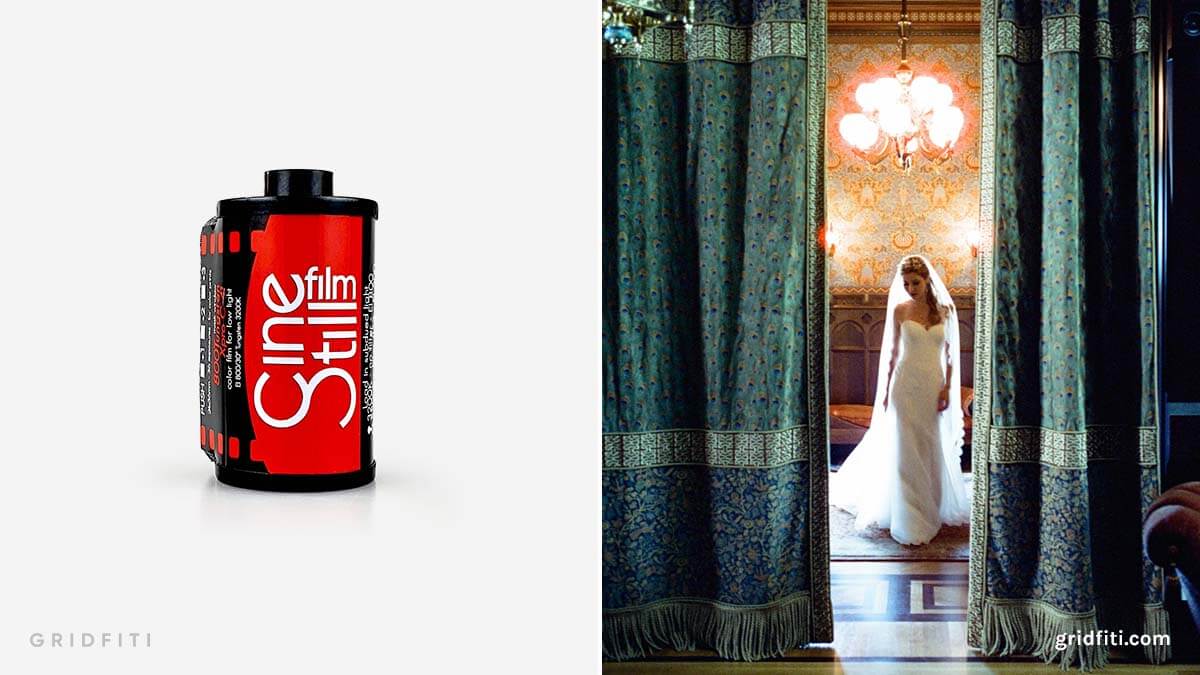 Photo by Gia Canali
Photo by Gia Canali
llford HP5 Plus 400
Ilford HP5 400 is synonymous with black and white film photography – no wonder it’s a favorite for wedding photos! With the yearning for wedding photos to appear timeless, HP5 achieves that with its iconic monochromatic look.
The 400 speed captures details wonderfully, while keeping grain at a minimum – and details are even retained in shadows and low light, compared to sharper blacks found with other B&W films. HP5’s exposure latitude is also very forgiving if your metering is off, which can happen in the fast-paced capture of weddings. Overall, Ilford HP5 Plus 400 is a perfect black and white film to capture your weddings.
Check out Ilford HP5 Plus 400:
- Ilford HP5 Plus 400 35mm Film: Get it on Amazon | Get it on Moment
- Ilford HP5 Plus 400 Medium Format (120) Film: Get it on Amazon | Get it on Moment
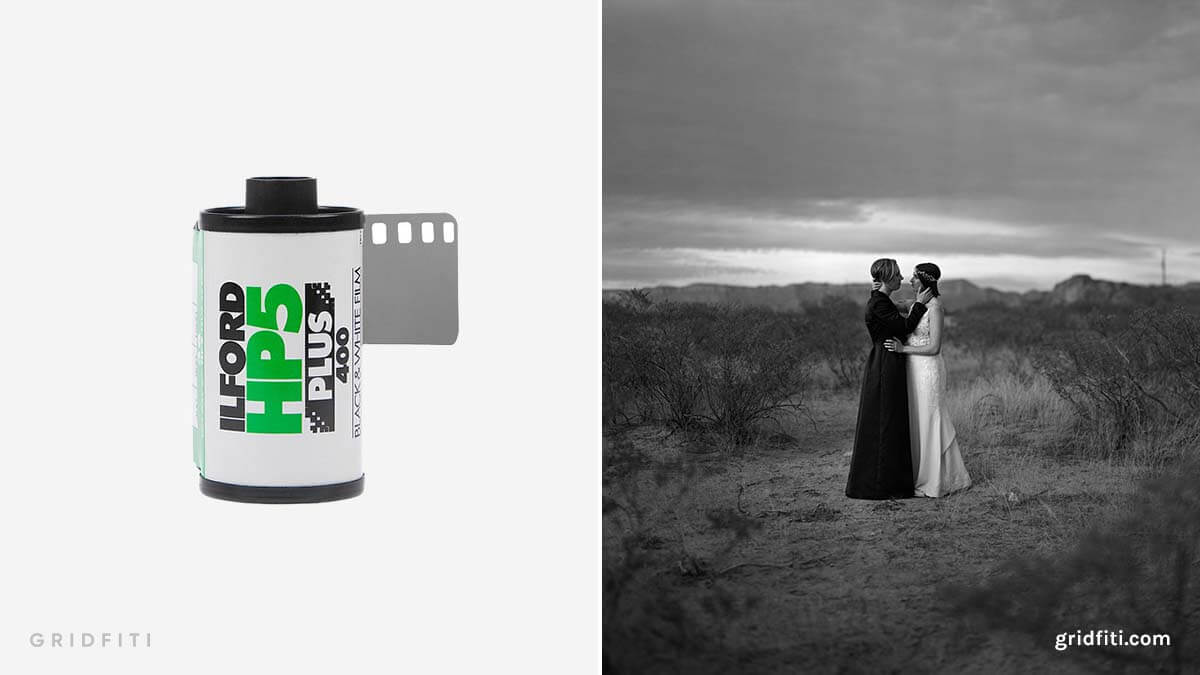 Photo by u/thesmithbrian
Photo by u/thesmithbrian
Ilford Delta 3200
Lastly, Ilford Delta 3200 with its ultra high speed ISO says it all. The high ISO of 3200 gets you a world of versatility when shooting throughout the changing conditions of the day. What else does 3200 get you? Grain. Lots of grain.
Contrary to what most might think, lots of grain can be good grain, especially during wedding capture when you’re trying to recreate a classic feel! When it comes to capturing movement such as dancing, walking, or running, Delta 3200 has got you. Especially if you’ve got a second film camera body strapped on you to rock this film stock, you’ll be ready to capture those dynamic action shots on the wedding day.
Check out Ilford Delta 3200:
- Ilford Delta 3200 35mm Film: Get it on Amazon
- Ilford Delta 3200 Medium Format (120) Film: Get it on Amazon
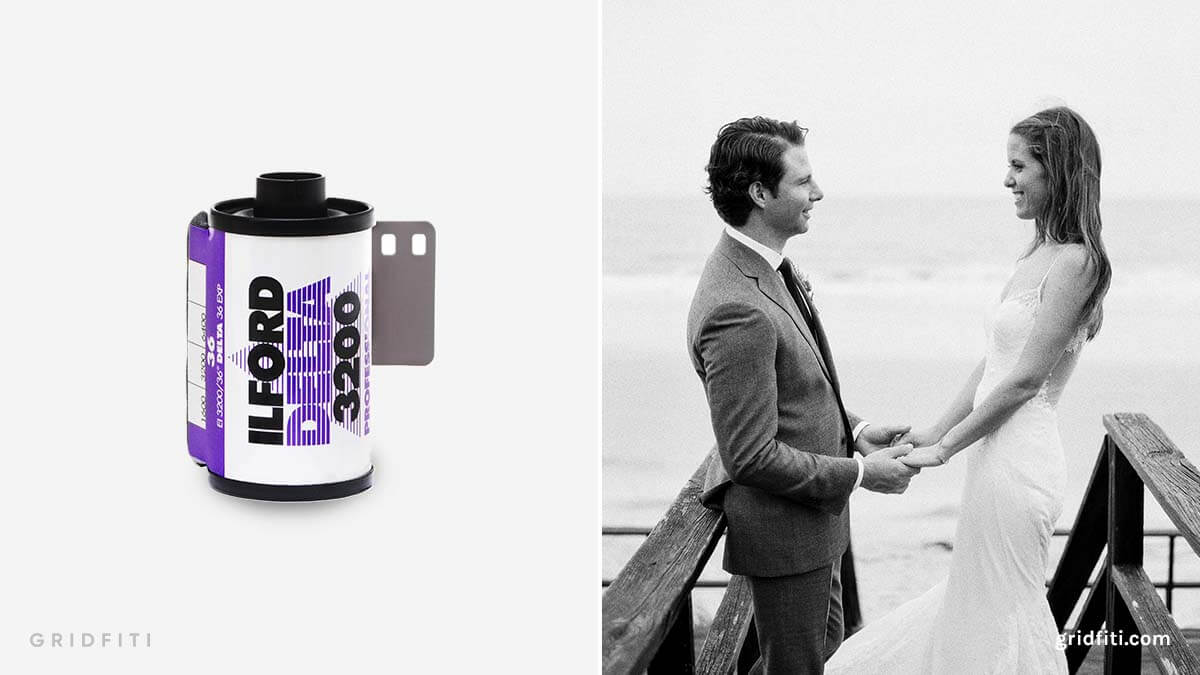 Photo by Bri and Smith Photography on Pinterest
Photo by Bri and Smith Photography on Pinterest
Which one of these film stocks for wedding photography are your favorites? Are there any you’re going to use? Let us know in the comments and tag us in your wedding film photos on Instagram @gridfiti.
Gridfiti is supported by its audience – when you buy something using the retail links in our posts, we may earn a small commission at no additional cost to you. Read more about our affiliate disclaimer.